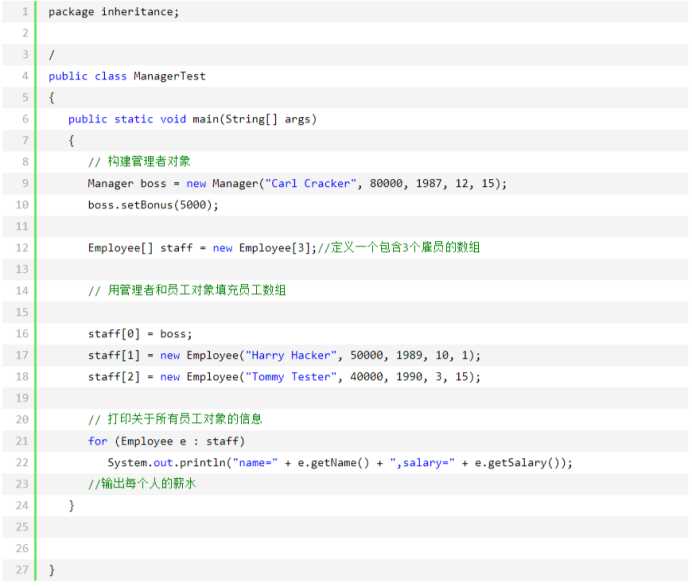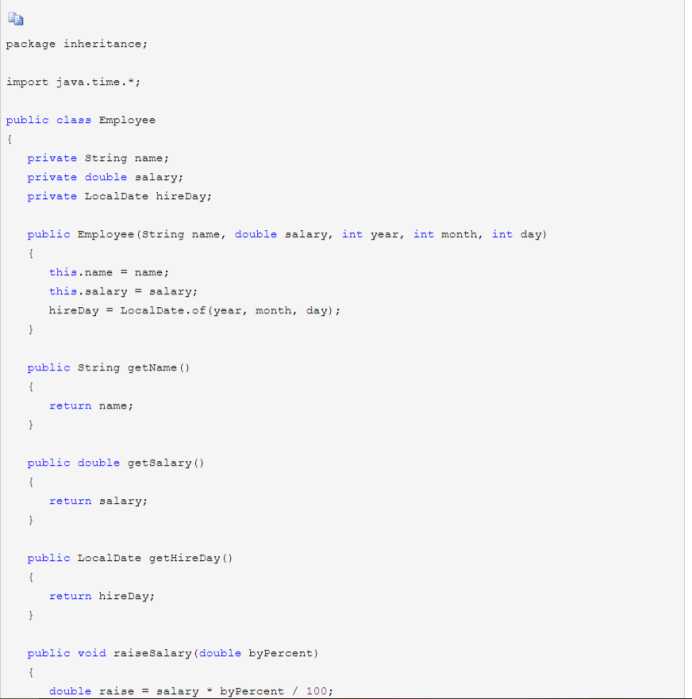201771010112罗松《面向对象程序设计(java)》第六周学习总结
2021-05-15 21:28
标签:while 编程 字段 文件读取 求和 今后 lis for cat 实验六 继承定义与使用 实验目的与要求: 在软件开发中,通过继承机制,可以利用已有的数据类型来定义新的数据类型。所定义的新的数据类型不仅拥有新定义的成员,而且还同时拥有旧的成员。因此,类的继承性使所建立的软件具有开放性开放性、可扩充性,这是信息组织与分类的行之有效的方法,通过类的继承关系,使公共的特性能够共享,简化了对象、类的创建工作量,增加了代码的可重用性。运行时多态性是面向对象程序设计代码重用的一个最强大机制,Java多态性的概念也可以被说成“一个接口,多个方法”。Java实现运行时多态性的基础是动态方法调度,它是一种在运行时而不是在编译期调用重载方法的机制。方法的重写Overriding和重载Overloading是Java多态性的不同表现。重写Overriding是父类与子类之间多态性的一种表现,重载Overloading是一个类中多态性的一种表现。如果在子类中定义某方法与其父类有相同的名称和参数,我们说该方法被重写(Overriding)。子类的对象使用这个方法时,将调用子类中的定义,对它而言,父类中的定义如同被“屏蔽”了。如果在一个类中定义了多个同名的方法,它们或有不同的参数个数或有不同的参数类型,则称为方法的重载(Overloading)。Overloaded的方法是可以改变返回值的类型。方法的重写Overriding和重载Overloading是Java多态性的不同表现。当超类对象引用变量引用子类对象时,被引用对象的类型而不是引用变量的类型决定了调用谁的成员方法,但是这个被调用的方法必须是在超类中定义过的,也就是说被子类覆盖的方法。 (但是如果强制把超类转换成子类的话,就可以调用子类中新添加而超类没有的方法了。 二、(1) 理解继承的定义;(2) 掌握子类的定义要求(3) 掌握多态性的概念及用法;(4) 掌握抽象类的定义及用途;(5) 掌握类中4个成员访问权限修饰符的用途;(6) 掌握抽象类的定义方法及用途;(7)掌握Object类的用途及常用API;(8) 掌握ArrayList类的定义方法及用法;(9) 掌握枚举类定义方法及用途。 2、实验内容和步骤 实验1: 导入第5章示例程序,测试并进行代码注释。 测试程序1:在elipse IDE中编辑、调试、运行程序5-1 (教材152页-153页) ;掌握子类的定义及用法;结合程序运行结果,理解并总结OO风格程序构造特点,理解Employee和Manager类的关系子类的用途,并在代码中添加注释。 测试实验结果如下: 插入此程序的代码并对其进行注释,进行更深一步的理解 ManaManager Emloyee: 子类的定义:在有继承关系的类中extends前面的类则是子类。 超类和子类都是Java程序员常用的两个类。 测试程序2: 编辑、编译、调试运行教材PersonTest程序(教材163页-165页); 掌握超类的定义及其使用要求; 掌握利用超类扩展子类的要求; 在程序中相关代码处添加新知识的注释。 超类:如果在程序中没有明确的之处超类,Object就是被认为是这个类的超类,如:Public class Employee extebds Object.在java中,每个类都是Object类扩展而来的。当然也可以使用Object类型的变量引用任何类型的对象。 超类扩展子类的要求 代码的注释: 测试程序3: 编辑、编译、调试运行教材程序5-8、5-9、5-10,结合程序运行结果理解程序(教材174页-177页); 掌握Object类的定义及用法; 在程序中相关代码处添加新知识的注释。 Employee.java: package equals; import java.time.*; import java.util.Objects; public class Employee { private String name; private double salary; private LocalDate hireDay; public Employee(String name, double salary, int year, int month, int day) { this.name = name; this.salary = salary; hireDay = LocalDate.of(year, month, day); } public String getName() { return name; } public double getSalary() { return salary; } public LocalDate getHireDay() { return hireDay; } public void raiseSalary(double byPercent) { double raise = salary * byPercent / 100; salary += raise; } public boolean equals(Object otherObject) { // 看看这些对象是否相同 if (this == otherObject) return true; // 如果显式参数为空,则必须返回false if (otherObject == null) return false; // 如果类不匹配,它们就不能相等 if (getClass() != otherObject.getClass()) return false; // 现在我们知道otherObject是一个非空雇员 Employee other = (Employee) otherObject; // 测试字段是否具有相同的值 return Objects.equals(name, other.name) && salary == other.salary && Objects.equals(hireDay, other.hireDay); } public int hashCode() { return Objects.hash(name, salary, hireDay); } public String toString() { return getClass().getName() + "[name=" + name + ",salary=" + salary + ",hireDay=" + hireDay + "]"; } } Manager.java: package equals; public class Manager extends Employee//子类Manager继承父类Employee { private double bonus; public Manager(String name, double salary, int year, int month, int day) { super(name, salary, year, month, day); bonus = 0; } public double getSalary() { double baseSalary = super.getSalary(); return baseSalary + bonus; } public void setBonus(double bonus) { this.bonus = bonus; } public boolean equals(Object otherObject) { if (!super.equals(otherObject)) return false; Manager other = (Manager) otherObject; // super.equals检查这个和其他属于同一个类 return bonus == other.bonus; } public int hashCode() { return java.util.Objects.hash(super.hashCode(), bonus); } public String toString() { return super.toString() + "[bonus=" + bonus + "]"; } } Equals.java: package equals; /** * This program demonstrates the equals method. * @version 1.12 2012-01-26 * @author Cay Horstmann */ public class EqualsTest { public static void main(String[] args) { Employee alice1 = new Employee("Alice Adams", 75000, 1987, 12, 15); Employee alice2 = alice1; Employee alice3 = new Employee("Alice Adams", 75000, 1987, 12, 15); Employee bob = new Employee("Bob Brandson", 50000, 1989, 10, 1); System.out.println("alice1 == alice2: " + (alice1 == alice2)); System.out.println("alice1 == alice3: " + (alice1 == alice3)); System.out.println("alice1.equals(alice3): " + alice1.equals(alice3)); System.out.println("alice1.equals(bob): " + alice1.equals(bob)); System.out.println("bob.toString(): " + bob); Manager carl = new Manager("Carl Cracker", 80000, 1987, 12, 15); Manager boss = new Manager("Carl Cracker", 80000, 1987, 12, 15); boss.setBonus(5000); System.out.println("boss.toString(): " + boss); System.out.println("carl.equals(boss): " + carl.equals(boss)); System.out.println("alice1.hashCode(): " + alice1.hashCode()); System.out.println("alice3.hashCode(): " + alice3.hashCode()); System.out.println("bob.hashCode(): " + bob.hashCode()); System.out.println("carl.hashCode(): " + carl.hashCode()); } } package equals; /** * This program demonstrates the equals method. * @version 1.12 2012-01-26 * @author Cay Horstmann */ public class EqualsTest { public static void main(String[] args) { Employee alice1 = new Employee("Alice Adams", 75000, 1987, 12, 15); Employee alice2 = alice1; Employee alice3 = new Employee("Alice Adams", 75000, 1987, 12, 15); Employee bob = new Employee("Bob Brandson", 50000, 1989, 10, 1); System.out.println("alice1 == alice2: " + (alice1 == alice2)); System.out.println("alice1 == alice3: " + (alice1 == alice3)); System.out.println("alice1.equals(alice3): " + alice1.equals(alice3)); System.out.println("alice1.equals(bob): " + alice1.equals(bob)); System.out.println("bob.toString(): " + bob); Manager carl = new Manager("Carl Cracker", 80000, 1987, 12, 15); Manager boss = new Manager("Carl Cracker", 80000, 1987, 12, 15); boss.setBonus(5000); System.out.println("boss.toString(): " + boss); System.out.println("carl.equals(boss): " + carl.equals(boss)); System.out.println("alice1.hashCode(): " + alice1.hashCode()); System.out.println("alice3.hashCode(): " + alice3.hashCode()); System.out.println("bob.hashCode(): " + bob.hashCode()); System.out.println("carl.hashCode(): " + carl.hashCode()); } } 测试程序4: 在elipse IDE中调试运行程序5-11(教材182页),结合程序运行结果理解程序; 掌握ArrayList类的定义及用法; 在程序中相关代码处添加新知识的注释。 插入程序相关代码 ArrayList.java: package arrayList; import java.util.*; /** * This program demonstrates the ArrayList class. * @version 1.11 2012-01-26 * @author Cay Horstmann */ public class ArrayListTest { public static void main(String[] args) { // 用三个Employee对象填充staff数组列表 ArrayList staff.add(new Employee("Carl Cracker", 75000, 1987, 12, 15)); staff.add(new Employee("Harry Hacker", 50000, 1989, 10, 1)); staff.add(new Employee("Tony Tester", 40000, 1990, 3, 15)); // 把每个人的薪水提高5% for (Employee e : staff) e.raiseSalary(5); // 打印所有Employee对象的信息 for (Employee e : staff) System.out.println("name=" + e.getName() + ",salary=" + e.getSalary() + ",hireDay=" + e.getHireDay()); } } Employee.java: package arrayList; import java.time.*; public class Employee { private String name; private double salary; private LocalDate hireDay; public Employee(String name, double salary, int year, int month, int day) { this.name = name; this.salary = salary; hireDay = LocalDate.of(year, month, day); } public String getName() { return name; } public double getSalary() { return salary; } public LocalDate getHireDay() { return hireDay; } public void raiseSalary(double byPercent) { double raise = salary * byPercent / 100; salary += raise; } } package arrayList; import java.time.*; public class Employee { private String name; private double salary; private LocalDate hireDay; public Employee(String name, double salary, int year, int month, int day) { this.name = name; this.salary = salary; hireDay = LocalDate.of(year, month, day); } public String getName() { return name; } public double getSalary() { return salary; } public LocalDate getHireDay() { return hireDay; } public void raiseSalary(double byPercent) { double raise = salary * byPercent / 100; salary += raise; } } 程序测试结果如下: 测试程序5: 编辑、编译、调试运行程序5-12(教材189页),结合运行结果理解程序; 掌握枚举类的定义及用法; 在程序中相关代码处添加新知识的注释。 插入实例程序的代码: package enums; import java.util.*; /** * This program demonstrates enumerated types. * @version 1.0 2004-05-24 * @author Cay Horstmann */ public class EnumTest { public static void main(String[] args) { Scanner in = new Scanner(System.in); System.out.print("Enter a size: (SMALL, MEDIUM, LARGE, EXTRA_LARGE) "); String input = in.next().toUpperCase(); Size size = Enum.valueOf(Size.class, input); System.out.println("size=" + size); System.out.println("abbreviation=" + size.getAbbreviation()); if (size == Size.EXTRA_LARGE) System.out.println("Good job--you paid attention to the _."); } } enum Size { SMALL("S"), MEDIUM("M"), LARGE("L"), EXTRA_LARGE("XL"); private Size(String abbreviation) { this.abbreviation = abbreviation; } public String getAbbreviation() { return abbreviation; } private String abbreviation; } 测试结果如下: 实验2:编程练习1 定义抽象类Shape: 属性:不可变常量double PI,值为3.14; 方法:public double getPerimeter();public double getArea())。 让Rectangle与Circle继承自Shape类。 编写double sumAllArea方法输出形状数组中的面积和和double sumAllPerimeter方法输出形状数组中的周长和。 main方法中 1)输入整型值n,然后建立n个不同的形状。如果输入rect,则再输入长和宽。如果输入cir,则再输入半径。 思考sumAllArea和sumAllPerimeter方法放在哪个类中更合适? 输入样例: 3 rect 1 1 rect 2 2 cir 1 输出样例: 18.28 8.14 [Rectangle [width=1, length=1], Rectangle [width=2, length=2], Circle [radius=1]] class Rectangle,class Shape class Rectangle,class Shape class Circle,class Shape 程序相关代码: shape: package shape; import java.util.Scanner; public class Test { public static void main(String[] args) { Scanner in = new Scanner(System.in); System.out.println("个数"); int a = in.nextInt(); System.out.println("种类"); String rect="rect"; String cir="cir"; Shape[] num=new Shape[a];








2) 然后输出所有的形状的周长之和,面积之和。并将所有的形状信息以样例的格式输出。
3) 最后输出每个形状的类型与父类型,使用类似shape.getClass()(获得类型),shape.getClass().getSuperclass()(获得父类型);
文章标题:201771010112罗松《面向对象程序设计(java)》第六周学习总结
文章链接:http://soscw.com/essay/85956.html

